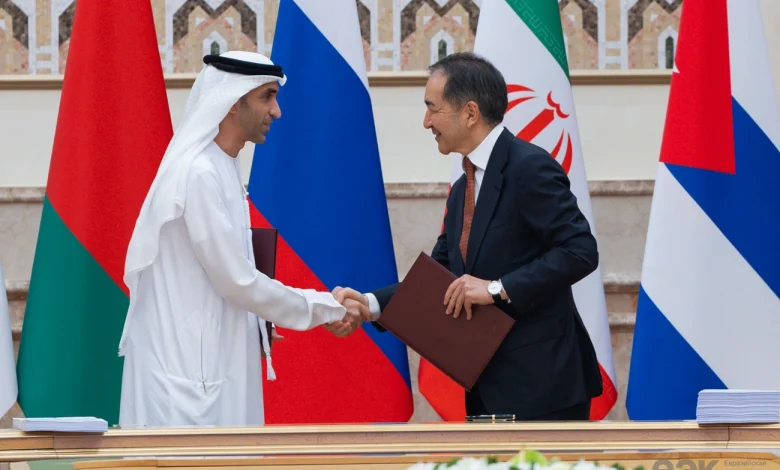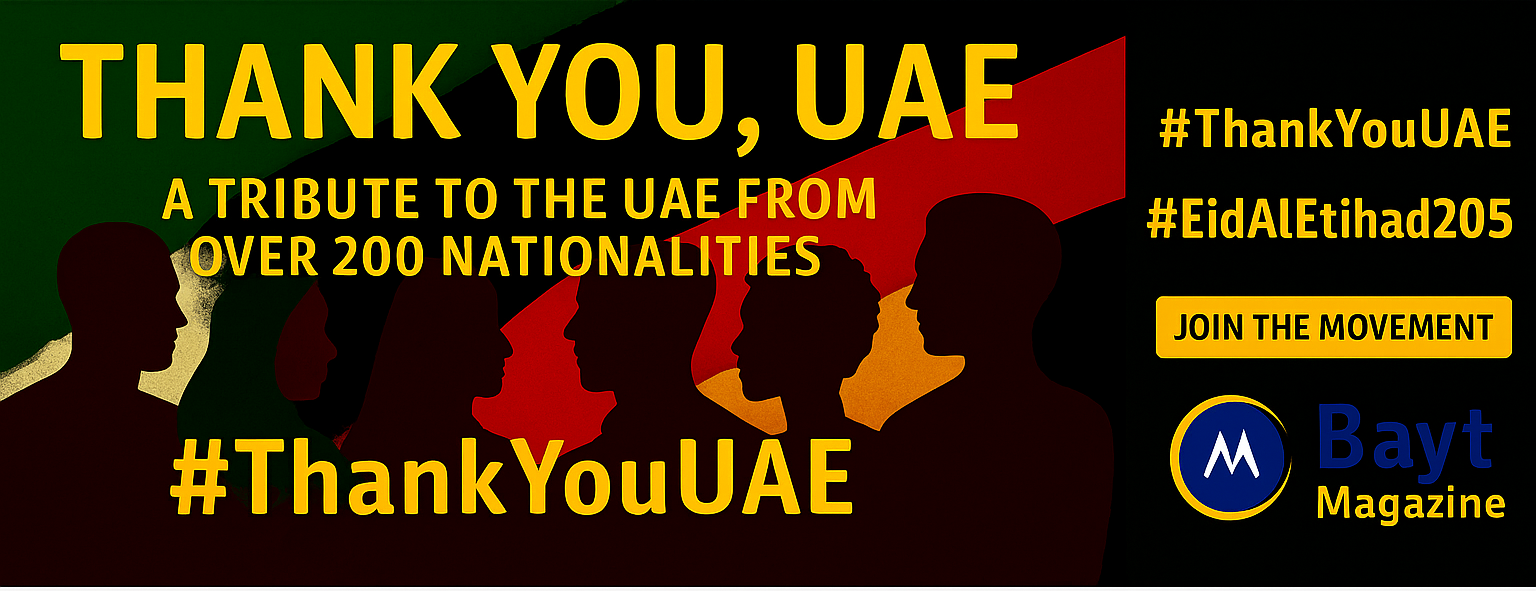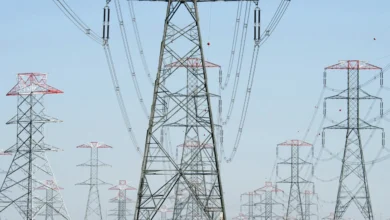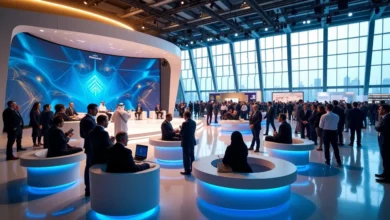
UAE-Eurasian Economic Union Trade Hits Record High
Trade between the UAE and Eurasian Economic Union has grown substantially. The UAE has become one of the bloc’s top ten global trading partners and represents two percent of its total foreign trade. The bilateral non-oil trade reached $13.7 billion in the first half of this year. This marks a 30% increase on an annual basis.
The trade momentum between these regions has reached new heights. The Union’s exports to the Emirates have quadrupled in the last two years. Emirati exports to Union markets have also risen by more than 50 percent. Both parties signed a detailed Economic Partnership Agreement (CEPA) to build on this success. This agreement reduces customs duties on more than 85 percent of goods. The customs protection rates for Eurasian Economic Union products in the Emirati market will drop from 5 percent to 0.6 percent. UAE products entering Eurasian Economic Union markets will see tariffs decrease from 5.9 percent to 1.5 percent. Emirati businesses can now access a market of over 180 million people. This expanded market access and evolving global trade dynamics offer substantial benefits to these businesses.
UAE Signs CEPA With Eurasian Economic Union
Image Source: Arabian Gulf Business Insight
The United Arab Emirates and the Eurasian Economic Union have completed negotiations for a Comprehensive Economic Partnership Agreement (CEPA). This framework will improve economic cooperation between both blocs. The groundbreaking deal covers the five EAEU member states: Armenia, Belarus, Kazakhstan, Kyrgyzstan, and Russia. It creates a resilient platform that expands trade relations.
The agreement will systematically remove trade barriers through several key mechanisms. It reduces tariffs, removes technical trade obstacles, opens market access, and aligns customs procedures. Andrey Slepnev, Minister in charge of Trade at the Eurasian Economic Commission, sees this partnership as a “strategic milestone” that strengthens economic ties between the UAE and the Eurasian bloc.
“The Economic Partnership Agreement with the UAE is a significant milestone, given the UAE’s role as a global hub in the region,” Slepnev stated. He added that the agreement “will provide an additional boost for mutual trade, which is already showing unprecedented growth, and create the systemic basis for cooperative ties.”
The CEPA with the Eurasian Economic Union lines up with UAE’s broader economic diversification strategy from 2021. The strategy wants to attract AED 550.79 billion in foreign investment. The agreement adds to UAE’s growing portfolio of international trade partnerships. The Emirates has approved agreements with India, Israel, Indonesia, Türkiye, Cambodia, and Georgia since starting its CEPA program.
UAE has expanded its global trade network further. It signed CEPA agreements with Serbia, Malaysia, and Jordan in October 2024. The country also secured bilateral trade agreements with Australia, Vietnam, and New Zealand in September of the same year.
UAE-EAEU partnership stands out because of rapid growth in bilateral relations. Minister Slepnev pointed out that trade has grown at an extraordinary pace. The Union’s exports to UAE have quadrupled in just two years. The Emirates has become a crucial trade hub for all EAEU countries. It now surpasses major international partners like Japan, Brazil, Egypt, and Vietnam.
The agreement focuses on high-priority sectors such as agriculture and industry. These sectors hold strategic importance for both parties. This comprehensive partnership creates a framework that tackles immediate trade concerns and builds foundations for long-term economic cooperation.
CEPA’s implementation will align digital trade and e-commerce practices between regions. It will create new shared platforms designed specifically for small and medium enterprises. These provisions show the agreement’s forward-looking nature that addresses both traditional and emerging areas of economic activity.
Trade Volume Between UAE and EAEU Surges
Trade relations between the United Arab Emirates and the Eurasian Economic Union have gained exceptional momentum recently. These relations have set new standards for commerce between both regions.
Non-oil trade hits $13.7 billion in H1 2024
The UAE and five Eurasian Economic Union member countries recorded non-oil trade worth AED 50.31 billion ($13.7 billion) in the first half of 2024. This amount showcases the success of their mutually beneficial alliance that has grown stronger over the last several years. Both parties have leveraged their economic strengths to increase trade across multiple sectors.
The UAE’s strong trade performance aligns with its expanding economy. The country’s total non-oil foreign trade reached AED 1.4 trillion in the first six months of 2024. This represents an 11.2% increase from the same period in 2023. Such growth has created ideal conditions for UAE’s thriving economic partnership with the Eurasian Economic Union.
Andrey Slepnev, Minister in charge of Trade at the Eurasian Economic Commission, emphasized how this relationship has reshaped the scene. The Union’s exports to the UAE have quadrupled in just two years. UAE’s exports to Union markets have grown by more than 50 percent during this period.
Slepnev described this growth as clear proof of “the strength of economic ties between the two sides”. The UAE now represents about two percent of the Eurasian Economic Union’s total foreign trade volume, making it a vital commercial partner for the bloc.
30% year-on-year growth in bilateral trade
Trade between the UAE and Eurasian Economic Union has expanded at an impressive rate. Bilateral non-oil trade grew by nearly 30% yearly. Official data shows a precise increase of 29.6% compared to 2023. These numbers highlight the fast-growing economic ties between both regions.
UAE Minister of State for Foreign Trade Thani bin Ahmed Al Zeyoudi shared some remarkable statistics. Non-oil trade between the UAE and Eurasian Economic Union countries jumped from AED 27.54 billion to AED 106.49 billion since 2021. This four-fold increase in three years shows the remarkable speed of commercial growth.
The new Comprehensive Economic Partnership Agreement aims to boost this growth by removing customs barriers and expanding traded goods. The agreement will cut customs duties on more than 85% of goods.
Eurasian Economic Union products entering UAE markets will see tariffs drop from 5% to 0.6%. UAE products going to Eurasian Economic Union markets will benefit from reduced customs rates – from 5.9% to 1.5%. These lower tariffs should help exporters on both sides by reducing costs.
The CEPA will “provide additional boost for mutual trade, which is already showing unprecedented growth, and create systemic basis for cooperative ties”. This formal agreement sets the stage for even faster trade growth between the UAE and Eurasian Economic Union in the coming years.
UAE Becomes Top-10 Global Partner for EAEU
Image Source: aurifer.tax
The United Arab Emirates has earned its place among the top ten global trading partners of the Eurasian Economic Union. This remarkable achievement emphasizes UAE’s growing influence in regional and international commerce. The five-nation Eurasian bloc includes Russia, Kazakhstan, Belarus, Armenia, and Kyrgyzstan.
UAE accounts for 2% of EAEU’s total foreign trade
UAE continues to expand its commercial presence within the Eurasian Economic Union’s global trade network. Andrey Slepnev, Minister in Charge of Trade at the Eurasian Economic Commission, reports that UAE’s share in the Union’s total foreign trade has reached two percent. These numbers show UAE’s position as a key economic partner for the Eurasian bloc.
“The UAE is one of the most prominent trading partners for EAEU countries, with its share in the Union’s total foreign trade rising to two percent,” Slepnev told Emirates News Agency. His statement shows how much the Eurasian Economic Union values its relationship with UAE.
The speed of this commercial relationship’s growth makes it even more impressive. The Union’s exports to UAE have grown four times in the last two years. UAE’s exports to Union markets have also jumped by more than 50 percent during this time. This growth shows what Slepnev called “the strength of economic ties between the two sides”.
Surpasses Japan, Brazil, and Egypt in trade volume
UAE has outperformed several major global economies in trade with the Eurasian Economic Union. Current figures show UAE does more business with EAEU than Japan, Brazil, Egypt, and Vietnam. This puts UAE ahead of countries that have bigger economies and older trade relationships with the Eurasian region.
“Thanks to this momentum, the UAE has become a central trading hub for all union countries, surpassing major international partners such as Japan, Brazil, Egypt, and Vietnam,” Slepnev explained. His words recognize UAE’s volume of trade and its role as a commercial center for the Eurasian Economic Union.
UAE’s location between East and West has helped create this success. Andrey Slepnev noted that UAE has become “a key trade hub for all EAEU countries”. UAE earned this status through its world-class logistics infrastructure, strategic location, and business-friendly regulations.
This trade growth aligns with UAE’s economic diversification strategy. UAE plans to attract AED 550.79 billion in foreign investment. Its thriving relationship with the Eurasian Economic Union shows this strategy works.
The Eurasian Economic Union gains access to a vital hub connecting the Middle East, Africa, and South Asia through UAE. The bloc, with 200 million people and a GDP near AED 18.36 trillion, sees UAE as a vital partner to expand its commercial reach beyond its borders.
CEPA Slashes Tariffs on Over 85% of Goods
Image Source: Gulf States Newsletter
The new Economic Partnership Agreement between the UAE and the Eurasian Economic Union focuses on cutting trade barriers. This marks a big step forward in economic cooperation between the regions. The deal will cut tariffs on more than 85% of goods traded between both parties.
Customs duties drop from 5% to 0.6% for EAEU goods
The Economic Partnership Agreement creates a trade framework that cuts customs rates for products from Eurasian Economic Union countries entering the UAE market. The tariffs will drop from 5% to just 0.6%.
This is a big deal as it means that exporters from Eurasian Economic Union countries will pay 92% less in duty costs to access the UAE market. These countries include Armenia, Belarus, Kazakhstan, Kyrgyzstan, and Russia. The deal gives special access to 86% of all traded goods.
These tariff cuts will save more than AED 954.70 million in import customs duties each year. This makes Eurasian Economic Union exporters much more competitive in the UAE market.
Steel, aluminum, and petrochemical manufacturers from the EAEU will benefit first. These industries are core strengths for several Eurasian Economic Union countries and will now have better access to UAE markets.
UAE exports see tariff cuts from 5.9% to 1.5%
UAE exporters will also pay much less when sending goods to Eurasian Economic Union countries. The deal cuts customs duties on UAE products from 5.9% to 1.5% in EAEU markets[142].
UAE exporters will save 75% in tariff costs. The EAEU has offered these benefits on 85% of all goods, opening new doors for UAE manufacturers and exporters.
The deal will eventually cover more than 98% of current exports, worth over AED 44.43 billion. UAE industrial goods will see major benefits, with 96.8% of exports getting lower tariffs, especially petroleum derivatives, ships, and metal products.
The tariff cuts will roll out gradually to help markets adjust smoothly. This gives businesses time to adapt their operations to the new trade environment.
The agreement does more than just cut tariffs. It creates a complete framework for trade between the regions. The goal is to coordinate customs procedures and standardize digital trade and e-commerce approaches. This will make business more predictable.
Minister Andrey Slepnev of the Eurasian Economic Commission said, “The agreement is really ambitious, and not only in terms of tariff liberalization, but also in terms of the regulatory environment it shapes”. Everything starts after all parties ratify the agreement.
Which Sectors Will Benefit From the Agreement?
The new Economic Partnership Agreement brings major benefits to key sectors in both the UAE and Eurasian Economic Union. This deal opens up trade opportunities in a variety of industries. Both sides will see better market access for their producers and manufacturers thanks to specific tariff cuts.
EAEU exports: metals, petrochemicals, dairy, transport
EAEU exporters will now enjoy better access to the UAE market in several important industrial sectors. Metal products—including steel and aluminum—will benefit by a lot from this new trade framework. The deal also makes it easier for EAEU petrochemical producers to export to the Emirates.
The agreement gives special treatment to processed foods like dairy products, confectionery items, and canned foods. EAEU businesses will also find it easier to sell:
- Agricultural products: Grains (wheat, barley, corn), meat (cattle, mutton), poultry, eggs, dried vegetables, vegetable oil, and honey
- Industrial goods: Metallurgy products (rolled alloy steel, pipes, iron, aluminum wire), petroleum products, and timber products (boards, plywood, furniture)
- Transport equipment: Railway containers, motor vehicles, and specialized machinery
This is a big deal as it means that EAEU producers will see their customs duties in the UAE market drop from 5% to just 0.6%.
UAE exports: polymers, cosmetics, home appliances
UAE businesses can now reach the 180-million-consumer EAEU market more easily. The deal particularly helps polymer exports—especially polyethylene and polypropylene—which are the life-blood of UAE’s industrial exports.
UAE’s consumer goods manufacturers will discover fresh opportunities in the EAEU market. The core team has identified cosmetics and home appliances as sectors that will thrive under this agreement.
UAE manufacturers can now supply more consumer products to the EAEU. These include perfumes, watches, and certain clothing items. UAE exports to EAEU markets will see tariff rates fall from 5.9% to just 1.5%.
The CEPA supports UAE’s broader economic vision through its detailed Economic Partnership Agreements program. The UAE has focused on logistics, clean energy, advanced technology, financial services, green industries, advanced materials, and environmentally responsible food systems.
The agreement shows how well these two economies complement each other. Each side gets better access where they’re strongest. Lower tariffs mean businesses in these industries can build new commercial relationships in both markets.
How UAE’s Infrastructure Supports Trade Expansion
Image Source: Dreamstime.com
The UAE’s reliable infrastructure supports its growing trade relationship with the Eurasian Economic Union. The country’s world-class systems give it significant advantages that help increase commercial flows between these regions.
Advanced ports and logistics systems
The UAE’s extensive maritime capabilities make it a preferred trading partner for Eurasian Economic Union member countries. Jebel Ali Port ranks among the world’s ten busiest container ports and handles more than 14 million containers each year. The port connects directly to over 140 ports globally, which helps move goods efficiently between the UAE and Eurasian Economic Union countries—especially Russia, Kazakhstan, and Belarus.
The UAE’s sophisticated air cargo network extends beyond its seaports. Dubai International Airport and Abu Dhabi International Airport process over 4.5 million tons of freight yearly. These airports create vital air links with major Eurasian Economic Union cities like Moscow, St. Petersburg, and Almaty.
The country’s integrated logistics zones link these transportation networks with warehousing, processing, and distribution facilities. These zones provide specialized services for key trade sectors. Metals, petrochemicals, and consumer goods are the foundations of UAE-Eurasian Economic Union commerce.
Role in North-South international transport corridor
The UAE’s strategic location makes it crucial to the developing North-South International Transport Corridor (INSTC). This multi-modal network connects Eurasian Economic Union members with markets across the Indian Ocean region. UAE ports give Russian and other northern Eurasian Economic Union countries a quick route to reach African and South Asian markets.
UAE ports cut shipping times between Eurasian Economic Union countries and India by up to 30% compared to traditional Suez Canal routes. This creates a great chance to boost regional trade. UAE logistics companies have responded by developing specialized services for this corridor. They now offer dedicated container terminals, customs support, and intermodal transfer capabilities.
These infrastructure advantages have helped the UAE become more than just a market for Eurasian Economic Union exports. The country now serves as an essential logistics partner that opens doors to broader global market access.
Why the UAE Is a Strategic Gateway for EAEU
Image Source: TraCCC – George Mason University
The United Arab Emirates serves as both a trade partner and a strategic gateway that connects the Eurasian Economic Union to key global markets. Andrey Slepnev highlighted this role when he said, “The UAE serves as an important trade gateway for Union countries to access Middle East and North African markets”.
Access to MENA, India, and South Asia
Natural pathways to three high-growth regions emerge from UAE’s prime location. These regions remain inaccessible through direct Eurasian Economic Union territories. The UAE has built extensive commercial networks throughout the MENA (Middle East and North Africa) region. This access grows more valuable as the UAE continues to expand its trade partnerships in these territories.
The UAE’s position within the North-South international transport corridor makes it a powerful regional hub for transit trade. This strategic location creates quick pathways to Gulf countries, India, and South Asia. Russian and other northern Eurasian Economic Union countries can now reach these markets more quickly through UAE ports than traditional routes.
This gateway has changed market accessibility for Eurasian Economic Union exporters. Slepnev emphasized this point when he noted that UAE’s logistical positioning “reinforces its role as a regional hub for transit trade”. Eurasian businesses can now utilize UAE’s well-established commercial networks across multiple continents.
Geopolitical neutrality and economic openness
UAE’s balanced geopolitical stance provides Eurasian Economic Union countries with a strategic advantage beyond its location. The Emirates maintains good relationships with global powers of all sizes. This makes it a neutral commercial hub where Eurasian businesses operate without political barriers.
UAE’s resilient infrastructure and business-friendly economic policies complement this neutrality. Eurasian Economic Union exporters find it easier to set up regional headquarters, distribution centers, and marketing operations that serve broader markets.
UAE’s economic openness shows through its strategy to expand beyond oil and gas sectors. Dr. Thani bin Ahmed Al Zeyoudi emphasized that UAE’s “commitment to open, rules-based trade serves as a central pillar of its economic policy”. This approach matches perfectly with Eurasian Economic Union members who want to reach more markets.
What the CEPA Means for Emirati Businesses
Image Source: N R Doshi & Partners
The CEPA with the Eurasian Economic Union marks a defining moment that lets Emirati enterprises expand their business across Eurasia. This agreement brings quick wins through lower tariffs and creates lasting strategic advantages as markets grow.
Access to 180M+ consumers in EAEU
UAE companies now have direct access to a market with more than 180 million consumers spread across five member states: Armenia, Belarus, Kazakhstan, Kyrgyzstan, and Russia. The economic bloc’s combined GDP reaches AED 18.36 trillion, which creates huge demand potential in multiple sectors.
UAE exporters will see dramatic cuts in tariff rates. Customs duties on Emirati products entering the Eurasian Economic Union will drop from 5.9% to just 1.5%. These savings make UAE goods more competitive throughout Eurasia. Companies can expect better profit margins as they face fewer obstacles in these northern markets.
Opportunities for SMEs and large enterprises
The agreement includes special provisions to promote SME partnerships, which creates new paths for smaller Emirati businesses to establish themselves in Eurasian markets. To cite an instance, UAE-based halal food startups could tap into Kazakhstan’s Muslim-majority market. E-commerce platforms like Noon might build partnerships with EAEU retailers to grow online sales.
Large Emirati enterprises can benefit from diverse supply chains. They can import raw materials and components from EAEU countries at lower costs to streamline manufacturing. UAE exporters of polymers, cosmetics, and home appliances will find improved market conditions as tariff barriers fall.
This agreement lines up with UAE’s broader AED 550.79 billion foreign investment strategy. Emirati businesses can attract EAEU firms for joint ventures in manufacturing and e-commerce sectors. The partnership ended up giving UAE companies a chance to leverage changing global trade patterns through this strategic northern corridor.
How the Deal Aligns With UAE’s Global Trade Vision
Image Source: LinkedIn
The UAE’s agreement with the Eurasian Economic Union is the life-blood of its ambitious global trade expansion framework. This strategic collaboration lines up with the Emirates’ broader economic diversification goals and positions the country as a crucial hub in evolving international trade corridors.
Part of $150B foreign investment strategy
The CEPA with the Eurasian Economic Union serves as a vital element in UAE’s complete economic diversification strategy announced in 2021. The extensive plan wants to attract AED 550.79 billion (approximately $150 billion) in foreign investment through targeted international partnerships. The agreement creates a formal framework that encourages investment flows between the regions to support this ambitious goal.
The UAE-EAEU partnership focuses on the Emirates’ economic vision’s priority sectors. These include logistics, clean energy technologies, advanced manufacturing, and green food systems. The agreement strengthens UAE’s position as a global commercial hub by establishing connections with an economic bloc that represents about 200 million consumers.
Complementary to deals with India, Israel, Turkey
The Eurasian Economic Union agreement enhances UAE’s growing portfolio of international trade partnerships. The Emirates has ratified agreements with India, Israel, Indonesia, Türkiye, Cambodia, and Georgia as part of its strategic CEPA program.
These agreements build a network of preferential trading relationships across Asia, Europe, and the Middle East. UAE expanded this network through CEPA agreements with Serbia, Malaysia, and Jordan in October 2024. The country also signed bilateral trade agreements with Australia, Vietnam, and New Zealand in September of the same year.
The Eurasian Economic Union’s integration into this framework creates mutually reinforcing trade corridors. UAE businesses can now use preferential access to both Indian and Eurasian markets. This opens opportunities for value-added processing and regional supply chain integration.
What Experts Say About the UAE-EAEU Partnership
Image Source: eec.eaeunion.org
Senior officials from both sides strongly believe in the UAE-EAEU partnership that could reshape regional trade dynamics.
Quotes from Andrey Slepnev and Thani Al Zeyoudi
Andrey Slepnev, Minister in charge of Trade at the Eurasian Economic Commission, described the agreement as “truly ambitious, not only in terms of tariff liberalization, but also in terms of the regulatory setting it creates”. He emphasized that “the UAE is offering preferential access to 86% of its product range for the Eurasian Economic Union, while the EAEU is reciprocating with 85% preferential access for UAE products”.
Slepnev confidently predicted that “shortly after the agreement comes into force, our trade may exceed AED 73.44 billion due to the combined efforts and dedicated work of businesses, the Eurasian Economic Commission and national regulators”.
Dr. Thani bin Ahmed Al Zeyoudi, UAE Minister of State for Foreign Trade, emphasized that the agreement “reflects the UAE’s strong confidence in positive international cooperation and the advancement of free, rules-based trade as a pillar of stability and economic progress on a worldwide scale”. He further noted that “the UAE and the Eurasian Economic Union have established a successful, fruitful partnership that is founded on a mutual dedication to long-term growth and economic diversification”.
Analyst views on long-term trade effect
Economic analysts see the UAE-EAEU agreement as a strategic element of Abu Dhabi’s broader vision to become a bridge between East and West. The deal showcases “a foreign policy rooted in sovereign decision-making, economic diversification, and multipolar engagement”.
Trade experts recognize broader benefits beyond commercial advantages. Slepnev noted that the agreement “will not only improve market access and eliminate trade barriers but will also open new avenues for economic and technological collaboration”. Observers acknowledge “the UAE’s key role as a global hub” that connects different economic regions.
The agreement aligns with UAE President Sheik Mohammad Bin Zayed’s vision to establish the country as “a global trade and logistics hub”. This positions UAE as a crucial link in evolving international trade networks.
The UAE-Eurasian Economic Union partnership marks a defining moment that changes regional trade dynamics. Over the last several years, this relationship has grown remarkably. The Emirates now ranks among the top ten global trading partners for the Eurasian bloc. Bilateral non-oil trade reached $13.7 billion during the first half of 2024. These strong economic ties between regions show a 30% annual growth that highlights rapid commercial expansion.
This flourishing relationship’s life-blood is the Comprehensive Economic Partnership Agreement. The most important tariff reductions across 85% of goods will change trade flows fundamentally. Customs duties for Eurasian goods entering UAE markets will drop from 5% to 0.6%. UAE exporters will see tariff cuts from 5.9% to 1.5% when they access Eurasian markets. These reductions remove major barriers that stymied commercial exchange before.
Raw numbers tell only part of the story. This partnership creates strategic advantages for both sides. UAE businesses now have preferential access to a market of more than 180 million consumers across five nations. Eurasian exporters gain a vital gateway to Middle Eastern, North African, and South Asian markets through UAE’s world-class logistics infrastructure. This mutually beneficial arrangement exploits complementary economic strengths in sectors like metals, petrochemicals, polymers, and consumer goods.
On top of that, it fits perfectly with UAE’s broader economic diversification vision and complements existing partnerships with India, Israel, Turkey, and others. This growing network of trade agreements makes the Emirates a vital nexus in evolving global commerce patterns. It reinforces UAE’s position as a strategic bridge between East and West.
Businesses in both regions can capitalize on unprecedented opportunities as implementation follows ratification. The UAE-EAEU partnership goes beyond a bilateral trade agreement. It provides a transformative framework that reshapes economic relationships across a big geographic expanse from Europe through Asia to the Middle East.





